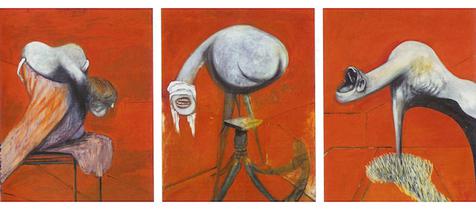The century abandoned me at dusk. I panicked and added more newsprint. Crappy friends leaving me, crappy artists, crappy bitter aphorisms pouring out of me, plasticky surgery belches, dapper, bandaged, trashed, honestly I behaved horribly. I’ve been lost a bit. It’s just dying, finally. Pity me, up and lead the dance of fate.
David Mitchell recently popularised the phrase (originally attributed to Martin Mull of all people), “Writing about music is like dancing about architecture”, and in the same vein, with The Death of Francis Bacon, author Max Porter ups the ante by not simply writing about painting but attempting to “write as painting” (according to a quote on his publisher’s website; emphasis my own). I confess to not being familiar with the life and work of the (surrealist? abstract impressionist?) British painter Francis Bacon, but I did do a shallow dive before starting this short novella and I would suggest that some such familiarity is absolutely necessary for anyone hoping to discover a few handholds of reality in this slippery, abstract work. And do you know what I discovered? I don’t really “get” or “like” the work of Francis Bacon. It’s too weird and ugly and unsettling, and by attempting to “replicate thought, struggle, the struggle of thought, but also the sheer energy of the eye’s confrontation with the painted image” through writing (an effort as sensical as dancing about architecture), Porter has created a narrative that is equally as weird, ugly, and unsettling — but with the added confusion of language. Were I a knowledgeable and devoted fan of Bacon’s work, I might have found this a brilliant bit of prose; but as a Philistine who would likely give Britain’s most famous and highest-selling artist a three star rating, I can only do the same for this novella. (Note: I read an ARC through NetGalley and passages quoted may not be in their final forms.)
It’s an attempt to express my feelings about a painter I have had a long unfashionable fixation with. It’s an attempt to get art history out of the way and let the paintings speak. It’s an attempt to hold catastrophe still so you can get a proper sniff at it.
I learned from my shallow dive into Bacon’s biography that he died in Madrid in 1992, spending the last six days of his life under the care of a nursing sister in a private clinic, the Handmaids of Maria. The Death of Francis Bacon covers these last six days, with Bacon more or less rambling on at Sister Mercedes about his life and work, referencing identifiable paintings and lovers and interviews as she encourages him to get some rest, intenta descansar. Each of the six short chapters (plus preface) begins with the dimensions of a painting (which other reviewers assure me relate to actual works) and the writing that follows is gritty, visceral, and closer to poetry than prose:
You look well Aelfryth, you look well Edward, long ride, good day, strong wind, sea air, here, some beer, a long gladdening gulp of gold, the colour of the stone, strange look, first cold, extremely cold and makes him think of river swims and soiling his sheets, shock, shame, the wet sock game, being stabbed is the same, extraordinary pain, the colour blue, lapis right through him, and then again and again and she’s walking back into the castle and he’s dripping venison memory, white fat and clicking, smoke, dripping onto the stones, trying to turn and see where the hurt is, caught in the stirrup and upside down, crack on the skull metal thump in the side in a brawl with the pages, again, crack again, black, bits of his brain scattered on the track thumping down the hill down the hill down the hill and into the river Corfe, last thought is of the beer, wasted, where is the cup, we are concerned with those who notice the cup, yes the dead king, yes politics, meat and temporality, but also the well-made cup, perched body ripe and crucial on the road.
As I said above, this is a very short work — it only takes about a half hour to read, so I went through it twice — and while it was the surrealism of Porter’s Lanny that most entranced me with that book, writing about surrealistic painting, once again, seems about as transferable as dancing about architecture (or “singing about economics” if you prefer; apparently the original original simile). This was interesting, I did appreciate what I learned on and off the page — and I will grant that a more knowledgeable reader might find this to be a perfect result of Porter’s intent — but it doesn’t go beyond a three star “like” for me.
Last sight isn’t human after all, is pure throb colour on the heart inside.
Get some distance, stand back, six feet, no glass, no label, no price list, no body, no gallerist. Just the painting. Seal the lid. Is pure throb colour on the heart inside.
No more.
Is pure throb colour on the heart inside.
Sí. Intenta descansar.


